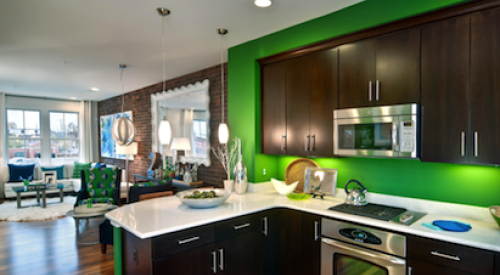| An interesting interior detail of Plan 3 at Castille at The Oaks of Calabasas (Calif.) is the hump movie theater. The community is one of the first offerings from the new Laing Luxury division. | ||||||||||||||
| An alternative exterior to Plan E at infill community Tapestry at Playa Vista (Calif.). See below for an interior view. | ||||||||||||||
|
Start with the already-established Luxury division, which will close only seven homes this year but hit $13.3 million in revenue. It might seem grandiose to project 70 closings for $134 million in 2004, but the projects to pull it off are open, selling briskly and drawing rave reviews. Homes priced above $1 million are not really a stretch for Laing, just a logical extension of its design leadership position into a pricing niche that allows its architecture to flourish.
The move to challenge The Olson Co. for leadership in California's inner-city and infill markets is a stretch but not a quantum leap. Laing has done some of this in the past, and the disappearance of vacant suburban land in its largest market, Orange County, makes the infill move more prudent than bold.
New divisions in San Diego and California's Central Valley markets such as Stockton and Modesto make sense as spinoffs from South Coast and Sacramento. Developing master-planned communities in the Inland Empire and Central Valley would protect Laing's lot supply and growth options while moving the company into a lucrative new business: selling lots to other builders.
How long it will take all of these plans to play out is the question. That, and to what extent they are predicated on California's housing boom continuing.
"The good news is we can finally do strategic planning for future years knowing we'll actually be here," CEO Larry Webb says. "We're projecting 2,200 to 2,400 units in 2005 for somewhere between $1.05 billion and $1.10 billion, and all of that is from existing divisions and people already on our payroll acquiring ground in existing markets.
"They have the relationships with land sellers to make these deals happen. We own or control all of the land for '04 and 60% or more of it for '05. There are deals in the pipeline that we'll finalize early in '04. We don't like to acquire ground and sit on it. We also don't like to buy lots at retail just to feed unit growth. We have the product skills to do all of this and the people in place to do 500 homes a year in each of our existing divisions."
Webb expects the fledgling operation under way in San Diego County to blossom into JLH's eighth division by the end of 2004. He's noncommittal on a time frame for a Central Valley division.
He says Laing will remain a production builder and continue to grow in all aspects of that business "from number of homes built, land controlled, bottom-line profit, net value of the company, equity, everything." But he's eager to move into large-scale land development and excited about urban regeneration and infill development plans. "We'll start in L.A. County because that's what we know," he says. "But there's no reason we can't go to other cities with this."
| This loft is found on the third level of Plan E at Tapestry at Playa Vista. The 2,608-square-foot model has three bedrooms and 3 1/2 bathrooms. |
Larry Webb runs one of the most aggressive home building companies anywhere at pushing prices. He makes certain John Laing Homes gets top dollar for its position as a design leader and an innovator in pleasing customers. But that doesn't mean he's happy about what market forces have done to housing affordability in Southern California.
"This whole housing affordability situation in California is just a sin," Webb says. "Our average selling price in Orange County is now almost $500,000.
"I want to create a nonprofit that's a separate operating entity, just to do affordable housing," he says wistfully. "I mean $80,000 detached houses, not $300,000 like some of the nonprofits we have now do. Our economies of scale in production building would allow us to do more houses - faster, better and priced lower.
"Before I'm done in home building, I want to build a lot of good houses, owner-occupied, that are really affordable. If we prove we can do it, cities will bring us the land in parcels big enough to make a difference. To do it right, we'd need to build hundreds of houses, not just a few at a time. All I'd need is three or four really focused people who care. We'd pay their salaries. I just want to break even on it.
"Maybe someday I'll run it and let somebody else run John Laing Homes."












